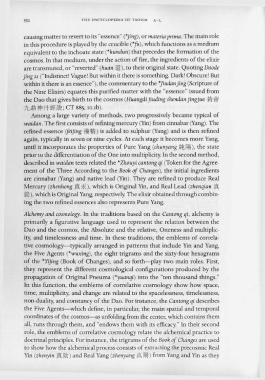Page 593 - The Encyclopedia of Taoism v1_A-L
P. 593
55 2 THE ENCYCLOPB DIA OP TAO ISM A- L
causing matter to revert to its " essence" (*jing), or materia prima. The main role
in this procedure is played by the crucible (*fu), which functions as a medium
equivalent to the inchoate state (*hundun) that precedes the formation of the
cosmos. In that medium, under the action of fire, the ingredients of the elixir
are transmuted, or "reverted" (huan .Q;;j:), to their original state. Quoting Daode
jing 2r ("Indistinct! Vague! But within it there is something. Dark! Obscure! But
within it there is an e sence"), the commentary to the *Jiudan jing ( cripture of
the Dao that gives birth to the cosmos (Huangdi jiuding shendan jingjue Ji *
the Nine Elixirs) equates this purified matter with the "essence" issued from
iL~;f$fl~~Wc; CT 885, ID.rb).
Among a large variety of methods, two progressively became typical of
waidan. The first consists of refining mercury (Yin) from cinnabar (Yang). The
refined essence (jeijing mffl) is added to sulphur (Yang) and is then refined
again, typically in seven or nine cycles. At each stage it becomes more Yang,
until it incorporates the properties of Pure Yang (chunyang t.f~ ~), the state
prior to the differentiation of the One into multiplicity. In the second method,
described in waidan texts related the *Zhouyi cantong qi (Token for the Agree-
ment of the Three According to the Book of Changes), the initial ingredients
are cinnabar (Yang) and native lead (Yin). They are refined to produce Real
Mercury (zhenhong ~7R), which is Original Ym, and Real Lead (zhenqian ~
~{f) , which is Original Yang, respectively. The elixir obtained through combin-
ing the two refined essences also represents Pure Yang.
Alchemy and cosmology. In the traditions based on the Can tong qi, alchemy is
primarily a figurative language used to represent the relation between the
Dao and the cosmos, the Absolute and the relative, Oneness and multiplic-
ity, and timelessness and time. In these traditions, the emblems of correla-
tive cosmology- typically arranged in patterns that include Yin and Yang,
the Five Agents (*wuxing), the eight trigrams and the sixty-four hexagrams
of the *Yijing (Book of Changes), and so forth-play two main roles. First,
they represent the different cosmological configurations produced by the
propagation of Original Pneuma (*yuanqi) into the "ten thousand things."
In this function, the emblems of correlative cosmology show how space,
time, multiplicity, and change are related to the spacelessness, timelessness,
non-duality, and constancy of the Dao. For instance, the Cantong qi describes
the Five Agents-which define, in particular, the main spatial and temporal
coordinates of the cosmos-as unfolding from the center, which contains them
all, runs through them, and "endows them with its efficacy." In their second
role, the emblems of correlative cosmology relate the alchemical practice to
doctrinal principles. For instance, the trigrams of the Book of Changes are used
to show how the alchemical process consists of extracting the precosmic Real
Yin (zhenyin ~~ ) and Real Yang (zhenyang ~ ~) from Yang and Yin as they

